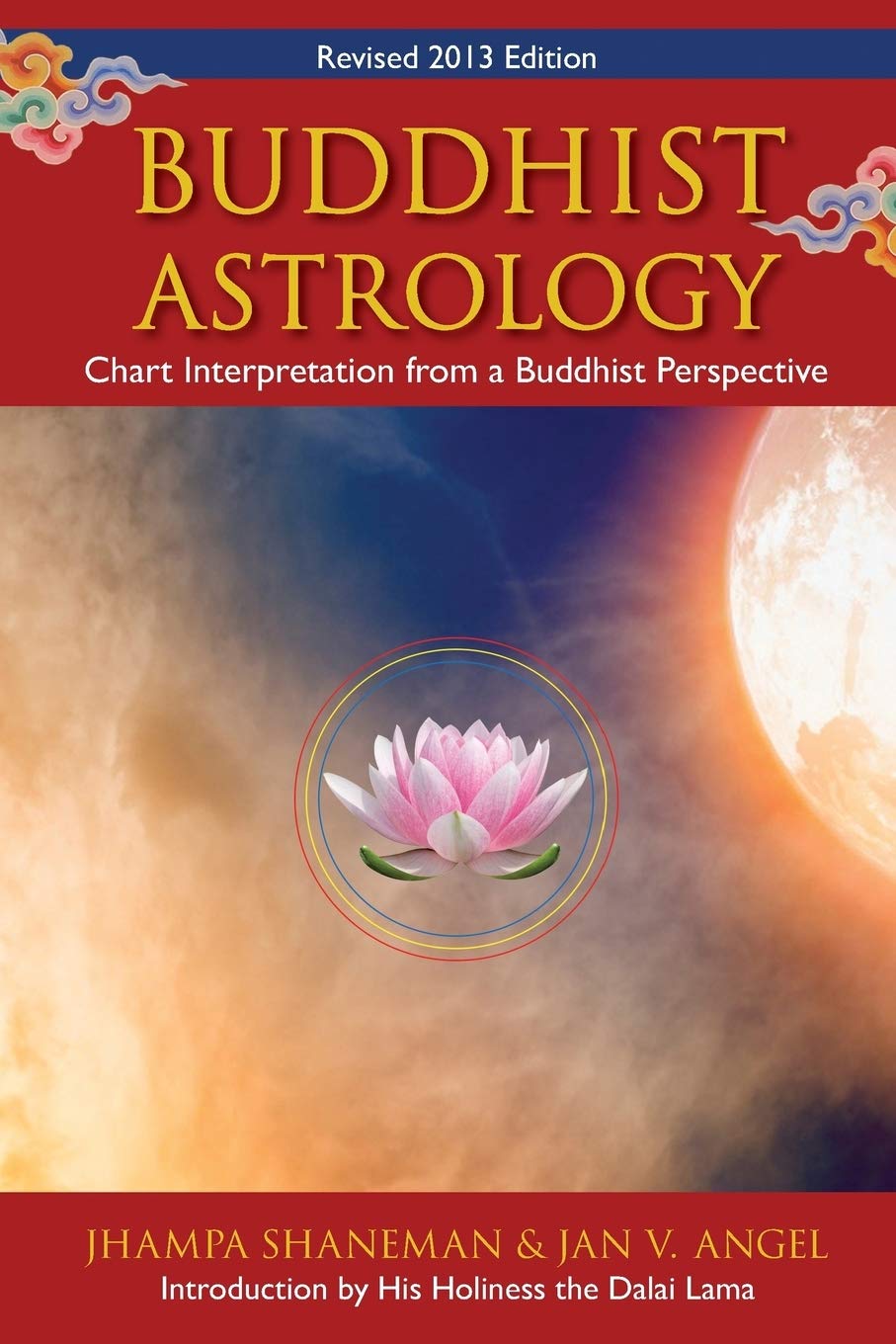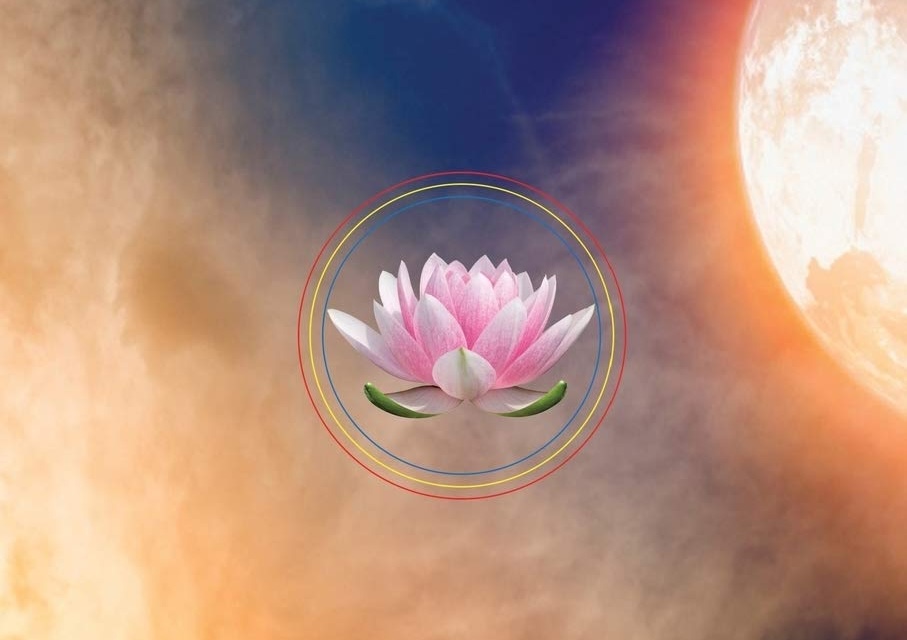Sumeru Press’s Buddhist Astrology, Chart Interpretation from a Buddhist Perspective, by Jhampa Shaneman and Jan Angel, was published with a preface by His Holiness the Dalai Lama and a foreword by the esteemed astrologer Steven Forrest, in 2002. It was revised in 2013 and is therefore far from new to our shelves. Yet when I was invited to dive into the books at Sumeru Press, which is Canada’s largest independent publishing house, this was one of the first books I was drawn to.
As someone with toes in both the worlds of Buddhism and astrology, I was curious as to how their marriage would be presented. And it didn’t disappoint.
Both Angel and Jhampa, practicing astrologers, also have had many years of Buddhism behind them. They had independently spent their early years in Asia during the early 70s. Jhampa was one of first Western ex-monks to study under Lama Yeshe. And I had the pleasure of chatting with Jhampa where, amongst other things, we discussed this book and the social evolution of both Buddhism and astrology over the years.
The book is essentially divided into the astrology of Siddhartha Gautama’s chart, an introduction to the idea of integrating our Western concepts of astrology with Buddhist principles and practice, and a useful cookbook of planetary placements for the reader, rounding off with a little of Jhampa’s own story for inspiration. In many respects this is a book that helps us seafarers of life tack the winds of the cosmos in the ship called Crucible, alchemizing our shadow, our unconscious behaviours and proclivities as well as helping us see the lighthouse on our own journey of awakening, even when that awakening is at the everyday level of mindful interactions and life choices.

To use the cookbook, having knowledge of your birth chart is invaluable for piecing together the information issued to us by our authors. While the planetary information may be considered bite-sized for the advanced astrology student, what’s covered is a sufficiently comprehensive array of planet positions from which we can derive applicable information. In fact, I like the idea of printing off each relevant section to create a personal blueprint which comes with the mindfulness and practice of Buddhist psychologym and how we can integrate any of this in our life, offering clarity on our path.
There was so much of this coupling of western astrology and Buddhist wisdom that not only made sense to me, but actively logical and obvious and certainly valuable for those who otherwise live in bifurcated disciplines.
“I feel that astrology offers a wonderful opportunity to recognize that we’re much more part of the environment than we often think,” says Jhampa. “So just as we have destroyed and polluted much of the planet by thinking we are outside of the environment, may we not do that. May we appreciate that we are a dynamic piece of this dynamic universe and that we should appreciate planet Earth isn’t a resource, but rather it’s our home and within that home there are a variety of factors that create who we are and what we are, which includes astrology.
“However, it’s important not to make it our religion. It is an interesting influence, but it’s what our attitude is that we bring to the situation that is more important.”
There is an interplay between praxis and theory. “Good astrologers are not just book learners. They have to be intuitive. You look at a chart and you have to think okay this person grew up in California versus growing up in Boston. Well, there’s going to be a different attitude, a different headspace to that. So, how you are going to talk about the chart is going to be a little different. Intuition has got to be in there, a lot,” continues Jhampa.
“Educationally, [today] everyone’s a lot more intelligent or well-educated in regards to Buddhism.” Jhampa notes that there is “a big influx of late 20 and 30-year-olds that are now really into their Buddhist practice and it is quite fun to see it and they’re well educated because there are the books out there.” In contrast, Jhampa had to learn Tibetan to learn Buddhism, and on top of that, there were only several books that were ever published and widely available.
Leaning into intuition, the astrology of the Buddha offered in the book is essentially based upon educated guesswork, which raised my question of whether we use our knowledge base, guised as intuition, to make an argument fit. We have over 2,500 years of the story of Buddha and many layers of cultural biases creating a myth of the being that we know today. And that it is very easy, very human in fact, to imbue this established character with the positions and transits of the constellations. I drive a hard line of questioning, but I feel it’s relevant to the integrity of the book.
In response, Jhampa had this to say:
”Well, I don’t disagree with you. There’s no birth date for Sakyamuni, so I went back 2,500 years approximately and then I looked for basic placements. He had a very unique life. His mother died shortly after birth and that put Chiron in, I think the seventh house conjunct his moon. I forget the details right now, but the other thing was a big placement in the ninth and third house, which gave him a huge philosophical nature and then an ability to be an educator.
“I searched for signs and came across a full Moon. According to the story, he was born, on a full moon. I looked for a set of aspects that matched and it came out pretty good. In the book I delineate the details fairly well.”
He does admit to employing a dash of fantasy on one side: “I mean it’s my fantasy of who he is, but he was an incredible being. He influenced the whole of Asia! He must’ve had some pretty spectacular astrology, and even in his birth story, his father invited an astrologer to come and the astrologer burst into tears having seen the chart. The king asked what was wrong. The seer said: ‘This boy is going to become so incredible and I’m so old I won’t see what’s going to happen.’ That’s why he was crying. So, put all that together and then I think he had a pretty outstanding astrology chart.”
But unlike many tellings of Shakyamuni’s years, Jhampa offers a far more real, even gritty version. “For example, Shakyamuni, in regards to sex, basically said (and remember, he was a crown prince that had hundreds of courtesans available for him as he grew up, so he had an ample sexual life prior to becoming a monk) in the commentaries: You should not try to make love more than six times one night,” he said. “But then you get these monks, over the next two millennia, and they put their opinions in there, and so suddenly you get all this discussion of what’s sexually appropriate and what’s not, and all the garbage that goes with male-female relationships.
“It’s good to recognize that all you needed was that influential monk, a while later, to start proselytizing his particular view on sexuality and women, and it’s all taken as being doctrine. But it’s his opinion. I have a bone to pick about a lot of the stuff that is said in regards to sexuality or women that comes out of some influential monk’s opinion about how things should be.”
What about Gautama himself? “What I wanted to do is to write him according to his astrology. It’s also more psychological, in the sense that you talk about his dealing with desire, anger, and power. I try to humanize him and astrology was a fun lens to do that through.”
Students of inner alchemy will find the study of astrology and Buddhism within these pages, a useful tool, as will those interested in seeing a human side to Gautama in contrast to the often romantacized iterations of his story. Jhampa’s conversation was dynamic and grounded, and I thank him for his time on the book and our time together.
“I would hope that Buddhist Astrology opens the mind of individuals who study astrology, to recognize that there are various ways to appreciate it.”


